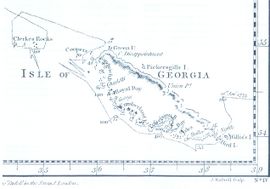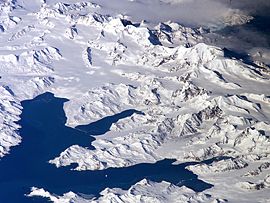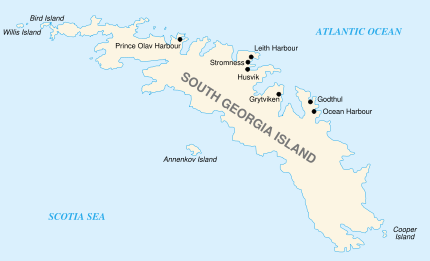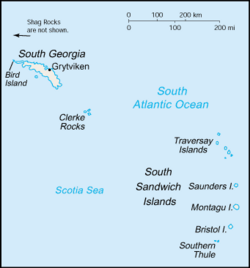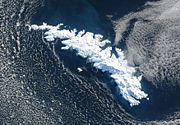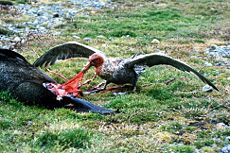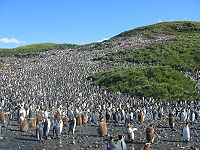South Georgia and the South Sandwich Islands
2008/9 Schools Wikipedia Selection. Related subjects: Antarctica
|
South Georgia and the South Sandwich Islands
|
||||||
|---|---|---|---|---|---|---|
|
||||||
| Motto: "Leo Terram Propriam Protegat" (Latin) "Let the Lion protect his own land" or "May the Lion protect his own land" |
||||||
| Anthem: " God Save the Queen" |
||||||
|
|
||||||
| Capital | King Edward Point ( Grytviken) | |||||
| Official languages | English | |||||
| Government | British Overseas Territory | |||||
| - | Head of State | Queen Elizabeth II | ||||
| - | Commissioner | Alan Huckle | ||||
| Area | ||||||
| - | Total | 3,903 km² 1,507 sq mi |
||||
| Population | ||||||
| - | 2006 estimate | ~20 ( n/a) | ||||
| - | Density | 0.005/km² ( n/a) 0.013/sq mi |
||||
| Currency | Pound sterling ( GBP) |
|||||
| Time zone | ( UTC-2) | |||||
| Internet TLD | .gs | |||||
South Georgia and the South Sandwich Islands (SGSSI) is a British overseas territory in the southern Atlantic Ocean. It is a remote and inhospitable collection of islands, consisting of South Georgia – which measures approximately 106 miles (170 km) by 18 miles (29 km) and is by far the largest island in the territory – and a chain of smaller islands known as the South Sandwich Islands lying about 400 miles to the south-east.
There is no native population on any of the islands, and the only present inhabitants are the British Government Officer, Deputy Postmaster, scientists, and support staff from the British Antarctic Survey who maintain scientific bases at Bird Island and at the capital, King Edward Point, as well as museum staff at nearby Grytviken.
The British claim to sovereignty of South Georgia dates from 1775, and that of the South Sandwich Islands from 1908. The territory of "South Georgia and the South Sandwich Islands" was formed in 1985; previously it had been governed as part of the Falkland Islands Dependencies. Argentina claimed South Georgia in 1927, and the South Sandwich Islands in 1938. Argentina maintained a naval station, Corbeta Uruguay, at Port Faraday on Thule Island in the South Sandwich Islands from 1976 until 1982 when it was closed by the Royal Navy. The Argentine claim over South Georgia contributed to the 1982 Falklands War, during which Argentine forces briefly occupied the Island, and remains unresolved to this day (see also Sovereignty of the Falkland Islands).
History
South Georgia
The Island of South Georgia is said to have been first sighted in 1675 by Anthony de la Roché, a London merchant, and was named Roche Island on some early maps, Pepys Island on others. It was sighted by a commercial Spanish ship named León operating out of Saint-Malo on 28 June or 29 June 1756, and in 1775 by Captain James Cook, who, after dismissing his find as "not worth the discovery", went on to survey and map the island, make the first landing, claim the territory for the Kingdom of Great Britain, and name it "the Isle of Georgia" in honour of King George III. British arrangements for the government of South Georgia were first established under the 1843 British Letters Patent.
In 1882 a German expedition sent out to observe the transit of Venus was stationed at Royal Bay on the south-east side of the island.
Throughout the 19th century South Georgia was a sealers' base and, in the following century, a whalers' base until whaling ended in the 1960s. The first land-based whaling station, and first permanent habitation, was established at Grytviken in 1904 by Norwegian Carl Anton Larsen. It operated through his Argentine Fishing Company, which settled in Grytviken. The station remained in operation until 1965.
Whaling stations operated under leases granted by the (British) Governor of the Falkland Islands. The seven stations, all on the north coast with its sheltered harbours were, starting from the west:
- Prince Olav Harbour (from 1911-1916 factory ship and small station, land-based station 1917–1931)
- Leith Harbour (1909–1965)
- Stromness (from 1907 factory ship, land-based station 1913–1931, repair yard to 1960/1961)
- Husvik (from 1907 factory ship, land-based station 1910–1960, not in operation 1930–1945)
- Grytviken (1904–1964)
- Godthul (1908–1929, only a rudimentary land base, main operations on factory ship)
- Ocean Harbour (1909–1920)
With the end of the whaling industry the stations were abandoned. Apart from a few preserved buildings such as the museum and church at Grytviken, only their decaying remains survive.
From 1905 the Argentine Meteorological Office cooperated in maintaining the meteorological observatory at Grytviken under the British lease requirements of the whaling station until these changed in 1949.
In 1908 the United Kingdom issued a further Letters Patent to establish constitutional arrangements for its possessions in the South Atlantic. As well as South Georgia, the Letters Patent covered the South Orkneys, the South Shetlands, the South Sandwich Islands, and Graham Land. (The claim was extended in 1917 to also include a sector of Antarctica reaching to the South Pole.) From 1909 an administrative centre and residence was established at King Edward Point on South Georgia, near the whaling station of Grytviken. A permanent local British administration and resident Magistrate exercised effective possession, enforcement of British law, and regulation of all economic, scientific and other activities in the territory, which was then governed as the Falkland Islands Dependencies.
In April 1916, Ernest Shackleton's Imperial Trans-Antarctic Expedition became stranded on Elephant Island, some 800 miles south west of South Georgia. Shackleton and five companions set out in a small boat to summon help, and on May 10, after an epic voyage, they landed at King Haakon Bay on South Georgia's south coast. They then covered 22 miles overland to reach help at Stromness whaling station. The remaining 22 members of the expedition, who had stayed on Elephant Island, were all subsequently rescued. In January 1922, during a later expedition, Shackleton died on board ship off South Georgia. He is buried at Grytviken.
Argentina claimed South Georgia in 1927.
During World War II, the Royal Navy deployed an armed merchant vessel to patrol South Georgian and Antarctic waters against German raiders, along with two four-inch shore guns (still present) protecting Cumberland Bay and Stromness Bay, manned by volunteers from among the Norwegian whalers. The base at King Edward Point was expanded as a research facility in 1949/1950 by the British Antarctic Survey (until 1962 called Falkland Islands Dependencies Survey).
The Falklands War was precipitated on 19 March 1982 when a group of Argentinians, posing as scrap metal merchants, occupied the abandoned whaling station at Leith Harbour on South Georgia. On April 3 the Argentine troops attacked and occupied Grytviken. Among the commanding officers of the Argentine Garrison was Alfredo Astiz, a Captain in the Argentine Navy who, years later, was convicted of felonies committed during the Dirty War in Argentina.
The island was recaptured by British forces on 25 April ( Operation Paraquet). From 1985, South Georgia and the South Sandwich Islands ceased to be administered as a Falkland Islands Dependency and became a separate territory. The King Edward Point base, which had become a small military garrison after the Falklands war, returned to civilian use in 2001 and is now operated by the British Antarctic Survey.
South Sandwich Islands
The southern eight islands of the Sandwich Islands Group were discovered by James Cook in 1775; the northern three by Fabian Gottlieb von Bellingshausen in 1819.[ clarification needed] They were named "Sandwich Land" by Cook after the 4th Earl of Sandwich, 1st Lord of the Admiralty. The word "South" was later added to distinguish them from the "Sandwich Islands", now known as " Hawaii".
The United Kingdom formally annexed the South Sandwich Islands through the 1908 Letters Patent, grouping them with other British-held territory in Antarctica as the Falkland Islands Dependencies.
Argentina claimed the South Sandwich Islands in 1938, and challenged British sovereignty in the Islands on several occasions. From January 25, 1955 through summer of 1956 Argentina maintained the summer station Teniente Esquivel at Ferguson Bay on the Southeastern coast of Thule Island. From 1976 to 1982, Argentina maintained a naval base named Corbeta Uruguay, at Port Faraday, in the lee (southern East coast) of the same island. Although the British discovered the presence of the Argentine base in 1978, protested and tried to resolve the issue by diplomatic means, no effort was made to remove them by force until after the Falklands War. The base was eventually removed on June 20, 1982.
On February 10, 2008 a small earthquake of magnitude 6.5 on the Richter Scale had its epicentre 205 km SSE of Bristol Island. On June 30, 2008 at 06:17:53 UTC, an earthquake of magnitude 7.0 struck the region. Its epicentre was at 58.160S 21.893W, 283 km (176 miles) ENE (73 degrees) of Bristol Island.
Geography
South Georgia and the South Sandwich Islands are a collection of bleak and remote islands in the South Atlantic Ocean. Most of the islands, rising steeply from the sea, are rugged and mountainous. At higher elevations the islands are permanently covered with ice and snow.
South Georgia Group
The South Georgia Group (Spanish name Georgias del Sur) lies about 864 miles east-southeast of the Falkland Islands, at 54°-55°S, 36°-38°W. It comprises South Georgia Island itself (by far the largest island in the territory), along with the islands that immediately surround it and some remote and isolated islets to the west and east-southeast. It has a total land area of 1,450 sq mi, including satellite islands (but excluding the South Sandwich Islands which form a separate island group).
Islands
South Georgia Island, also called Pepys Island (San Pedro in Spanish), lies at Coordinates: and has an area of 2,192 sq mi. It is mountainous and largely barren. Eleven peaks rise to over 6,562 feet high, their slopes furrowed with deep gorges filled with glaciers ( Fortuna Glacier being the largest). The highest peak is Mount Paget in the Allardyce Range at 9,626 ft.
Geologically, the island consists of gneiss and argillaceous schists, with no trace of fossils, showing that the island is, like the Falkland Islands, a surviving fragment of some greater land-mass now vanished, most probably indicating a former extension of the Andean system.
Smaller islands and islets off the coast of South Georgia Island include:
- Annenkov Island
- Bird Island
- Cooper Island
- Grass Island
- Pickersgill Islands
- Welcome Islands
- Willis Islands
- Trinity Island
The following remote rocks are also considered part of the South Georgia Group:
- Shag Rocks
- 185 km (115 mi)
- west-northwest of South Georgia Island
- Black Rock
- 169 km (105 mi)
- west-northwest of South Georgia Island
- 16 km (10 mi) southeast of the Shag Rocks
- west-northwest of South Georgia Island
- Clerke Rocks
- 56 km (35 mi)
- east-southeast of South Georgia Island
South Sandwich Islands
The South Sandwich Islands (Spanish name: Islas Sandwich del Sur) comprise 11 mostly volcanic islands (excluding tiny satellite islands and offshore rocks), with some active volcanoes. They form an island arc running from north to south in the region 56°18'–59°27'S, 26°23'–28°08'W, between about 350 miles (563 km) and 500 miles (805 km) south east of South Georgia.
The northernmost of the South Sandwich Islands form the Traversay Islands and Candlemas Islands groups, while the southernmost make up Southern Thule. The three largest islands – Saunders, Montagu and Bristol – lie between the two. The Islands' highest point is Mount Belinda (1,370 m / 4,495 ft) on Montagu Island.
The South Sandwich Islands are uninhabited, though a permanently manned Argentine research station was located on Thule Island from 1976 to 1982 (for details, see "History" section above). There are automatic weather stations on Thule (Morrell) Island and Zavodovski. To the northwest of Zavodovski Island is the Protector Shoal, a submarine volcano.
The following table lists the South Sandwich Islands from north to south:
| Island (Spanish Name) | Area | Highest Peak | Location | |
| Traversay Islands | ||||
| Protector Shoal | — | Protector Shoal: -27 m (-89 ft) | ||
| Zavodovski | 25 km² (10 sq mi) | Mount Curry: 550 m (1,804 ft) | ||
| Leskov | 0.3 km² (0.1 sq mi) | Rudder Point: 190 m (623 ft) | ||
| Visokoi | 35 km² (14 sq mi) | Mount Hodson: 915 m (3,002 ft) | ||
| Candlemas Islands (sometimes included with Traversay Islands) | ||||
| Candlemas (Candelaria) | 14 km² (5 sq mi) | Mount Andromeda: 550 m (1,804 ft) | ||
| Vindication (Vindicación) | 5 km² (2 sq mi) | Quadrant Peak: 430 m (1,411 ft) | ||
| Central islands | ||||
| Saunders | 40 km² (15 sq mi) | Mount Michael: 990 m (3,248 ft) | ||
| Montagu (Jorge) | 110 km² (42 sq mi) | Mount Belinda: 1,370 m (4,495 ft) | ||
| Bristol (Blanca) | 46 km² (18 sq mi) | Mount Darnley: 1,100 m (3,609 ft) | ||
| Southern Thule (Tule del Sur) | ||||
| Bellingshausen | 1 km² (0.4 sq mi) | Basilisk Peak: 255 m (837 ft) | ||
| Cook | 20 km² (8 sq mi) | Mount Harmer: 1,115 m (3,658 ft) | ||
| Thule or Morrell Island | 14 km² (5 sq mi) | Mount Larsen: 710 m (2,329 ft) | ||
| Vysokaya Bank | — | Vysokaya Bank: -? | ||
| South Sandwich Islands | 310 km² (120 sq mi) | Mount Belinda: 1,370 m (4,495 ft) | ||
Climate
The permanently cold sea maintains a cold maritime climate on the islands, and the weather is very variable and harsh. Typical daily maximum temperatures in South Georgia at sea level are around 0°C (32°F) in winter (August) and 8°C (46°F) in summer (January). Winter minimum temperatures are typically about −5°C (23°F) and rarely dip below −10°C (14°F). Annual precipitation in South Georgia is about 1500 mm (59 in), much of which falls as sleet or snow, which is possible in any month. Inland, the snow line in summer is at an altitude of about 300m.
Westerly winds blow throughout the year interspersed with periods of calm. This gives the eastern side of South Georgia (leeward side) a much pleasanter climate than the exposed western side. The prevailing weather conditions generally make the islands difficult to approach by ship, though the north coast of South Georgia has several large bays which provide good anchorage. During mountain wind conditions, the winds blow straight up the western side and straight down the eastern side of the mountains and become much warmer and drier; this produces the most pleasant conditions when temperatures can occasionally rise over 20°C on summer days. The highest recorded temperature was 23°C at Grytviken.
The seas surrounding South Georgia are cold throughout the year due to the proximity of the Antarctic Current. They usually remain free of pack ice in winter, though thin ice may form in sheltered bays, and icebergs are common. Sea temperatures drop to 0°C in late August and rise to around 4°C only in early April.
The South Sandwich Islands are much colder than South Georgia, being further south and more exposed to cold outbreaks from the Antarctic continent. They are also surrounded by sea ice from the middle of May to late November (even longer at their southern end).
Politics
Executive power is vested in The Queen and is exercised by the Commissioner, a post held by the Governor of the Falkland Islands. The current Commissioner is Alan Huckle; he became Commissioner on 25 August 2006. A Chief Executive Officer (Harriet Hall) deals with policy matters and is also Director of SGSSI Fisheries, responsible for the allocation of fishing licenses. An Executive Officer (Richard McKee) deals with administrative matters relating to the territory. The Financial Secretary and Attorney General of the territory are appointed ex officio similar appointments in the Falkland Islands' Government.
As there are no permanent inhabitants on the islands, there is no legislative council and no elections are held. The UK Foreign Office manages the foreign relations of the territory. Since 1982, the territory celebrates Liberation Day on June 14.
The constitution of the territory (adopted 3 October 1985), the manner in which its government is directed, and the availability of judicial review were discussed in a series of litigations in 2001 to 2005; see in particular Regina v. Secretary of State for Foreign and Commonwealth Affairs (Appellant) ex parte Quark Fishing Limited [2005] UKHL 57. Although its government is entirely directed by the UK Foreign Office, it was held that its decisions under that direction could not be challenged as if they were in law decisions of a UK government department; thus the European Convention on Human Rights did not apply.
Economy
As there are no native inhabitants, economic activity in South Georgia and the South Sandwich Islands is limited. The territory has revenues of UK£3.9 million, 90% of which is derived from fishing licences (2002 figures). Other sources of revenue are the sale of postage stamps and coins, tourism and customs and harbour dues.
Fishing
Fishing takes place around South Georgia and in adjacent waters in some months of the year, with fishing licences sold by the territory for Patagonian toothfish, icefish and krill. Fishing licences bring in a handful of million pounds a year, most of which is spent on fishery protection and research. All fisheries are regulated and managed in accordance with the Convention for the Conservation of Antarctic Marine Living Resources (CCAMLR) system. In 2001, the South Georgia government received a certificate from the Marine Stewardship Council for its sustainable Patagonian toothfish fishery, which certifies that they met the MSC's environmental standards and places limits on the timing and quantity of Patagonian toothfish that may be caught.
Tourism
Tourism has become a larger source of income in recent years, with many cruise ships and sailing yachts visiting the islands (the only way to visit South Georgia is by sea). The territory gains income from landing charges and the sale of souvenirs. Cruise ships often combine a Grytviken visit with a trip to the Antarctic Peninsula. Charter yacht visits usually begin in the Falkland Islands, last between four and six weeks, and enable guests to visit remote harbors of South Georgia and even the South Sandwich Islands. Sailing vessels are now required to anchor out and can no longer tie up to the old whaling piers on shore. The island has also featured in the Warren Miller video 'Storm'.
Postage stamps
A large source of income from abroad also comes from the issue of South Georgia and the South Sandwich Islands postage stamps which are produced in the UK.
A reasonable policy (few sets of stamps are issued each year) along with attractive subject matter (especially whales) makes them very popular with topical stamp collectors.
Flora and fauna
South Georgia supports a great number of sea birds, including albatross, a large colony of King Penguins and penguins of various other species, along with petrels, prions, shags, skuas, gulls and terns. There is only one land species which is unique to the archipelago however, the South Georgia Pipit.
Seals are frequent on the islands, and whales may be seen in the surrounding waters. There are no native land mammals, though reindeer, introduced early in the 20th century, live on South Georgia, along with rats and mice.
Native vegetation on South Georgia is limited to grasses, mosses, lichens, ferns and a few other small flowering plants. A number of other introduced species have become naturalised. There are no trees or shrubs.
Military
After the Falklands War in 1982, a full-time British military presence was maintained at King Edward Point. This was scaled down during the 1990s, and the last detachment left South Georgia in March 2001, when the new station was built and occupied by the British Antarctic Survey.
The main British military facility in the region is at RAF Mount Pleasant (and Mare Harbour) on East Falkland. Other than that, a handful of British naval vessels patrol the region. They visit South Georgia a few times each year, sometimes deploying small patrols of infantry. Flights by RAF C130 Hercules and VC10 aircraft occasionally patrol the territory.
HMS Endurance, the British Royal Navy ice patrol ship, operates in the South Georgia area during part of most southern summer seasons. She carries out hydrological and mapping work as well as assisting with scientific fieldwork for the British Antarctic Survey, high-profile film and photographic units, and youth expedition group BSES Expeditions.



